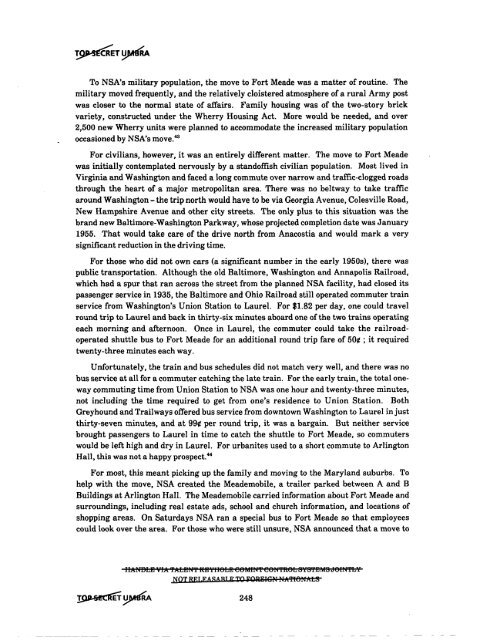American Cryptology during the Cold War - The Black Vault
American Cryptology during the Cold War - The Black Vault
American Cryptology during the Cold War - The Black Vault
You also want an ePaper? Increase the reach of your titles
YUMPU automatically turns print PDFs into web optimized ePapers that Google loves.
To NSNs military population, <strong>the</strong> move to Fort Meade was a matter of routine. <strong>The</strong><br />
military moved frequently, and <strong>the</strong> relatively cloistered atmosphere of a rural Army post<br />
was closer to <strong>the</strong> normal state of affairs. Family housing was of <strong>the</strong> two-story brick<br />
variety, constructed under <strong>the</strong> Wherry Housing Act. More would be needed, and over<br />
2,500 new Wherry units were planned to accommodate <strong>the</strong> increased military population<br />
occasioned by NSNs move. 43<br />
For civilians, however, it was an entirely different matter. <strong>The</strong> move to Fort Meade<br />
was initially contemplated nervously by a standoffish civilian population. Most lived in<br />
Virginia and Washington and faced a long commute over narrow and traffic-clogged roads<br />
through <strong>the</strong> heart of a major metropolitan area. <strong>The</strong>re was no beltway. to take traffic<br />
around Washington - <strong>the</strong> trip north would have to be via Georgia Avenue, Colesville Road,<br />
New Hampshire Avenue and o<strong>the</strong>r city streets. <strong>The</strong> only plus to this situation was <strong>the</strong><br />
brand new Baltimore-Washington Parkway, whose projected completion date was January<br />
1955. That would take care of <strong>the</strong> drive north from Anacostia and would mark a very<br />
significant reduction in <strong>the</strong> driving time.<br />
For those who did not own cars (a significant number in <strong>the</strong> early 1950s), <strong>the</strong>re was<br />
public transportation. Although <strong>the</strong> old Baltimore, Washington and Annapolis Railroad,<br />
which had a spur that ran across <strong>the</strong> street from <strong>the</strong> planned NSA facility, had closed its<br />
passenger service in 1935, <strong>the</strong> Baltimore and Ohio Railroad still operated commuter train<br />
service from Washington's Union Station to Laurel. For $1.82 per day, one could travel<br />
round trip to Laurel and back in thirty-six minutes aboard one of <strong>the</strong> two trains operating<br />
each morning and afternoon. Once in Laurel, <strong>the</strong> commuter could take <strong>the</strong> railroadoperated<br />
shuttle bus to Fort Meade for an additional round trip fare of 50¢ ~ it required<br />
twenty-three minutes each way.<br />
Unfortunately, <strong>the</strong> train and bus schedules did not match very well, and <strong>the</strong>re was no<br />
bus service at all for a commuter catching <strong>the</strong> late train. For <strong>the</strong> early train, <strong>the</strong> total oneway<br />
commuting time from Union Station to NSA was one hour and twenty-three minutes,<br />
not including <strong>the</strong> time required to get from one's residence to Union Station. Both<br />
Greyhound and Trailways offered bus service from downtown Washington to Laurel injust<br />
thirty-seven minutes, and at 99¢ per round trip, it was a bargain. But nei<strong>the</strong>r service<br />
brought passengers to Laurel in time to catch <strong>the</strong> shuttle to Fort Meade, so commuters<br />
would be left high and dry in Laurel. For urbanites used to a short commute to Arlington<br />
Hall, this was not a happy prospect. 44<br />
For most, this meant picking up <strong>the</strong> family and moving to <strong>the</strong> Maryland suburbs. To<br />
help with <strong>the</strong> move, NSA created <strong>the</strong> Meademobile, a trailer parked between A and B<br />
Buildings at Arlington Hall. <strong>The</strong> Meademobile carried information about Fort Meade and<br />
surroundings, including real estate ads, school and church information, and locations of<br />
shopping areas. On Saturdays NSA ran a special bus to Fort Meade so that employees<br />
could look over <strong>the</strong> area. For those who were still unsure, NSA announced that a move to<br />
II:AUBf::e '(I:A 'f:Af::er,'f IEfJ'iH6f::fJ e6~fH,'f e6H'fft6f:: SYS'ffJMS d6IN'ff::Y<br />
NOT RELEASABI Fro fOREI6NNA'f16r,:ALS<br />
248
















